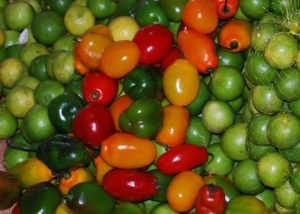Peru’s Hot Peppers Fit a Meaningful Pattern

The world is filled with patterns. Sometimes they mean something and sometimes they do not. But when they line up with other important arrangements it means you have to at least look at them seriously. One such organizes the four peppers that are classic in Peru and neighboring Bolivia.
These four peppers are:
- The rocoto whose name is almost synonymous with hot pepper in Cuzco, round and fat with enough heat to dispel any winter’s gloom;
- The limo, sleek and elegant yet excessively hot, a beauty with its waxy skin and varied colors as well as its fragrance that would make a Parisian parfumier seek its secret;
- The panca dried and rich like jungle mahogany aged over years into a glowing perfection with the scent as complex as that of the holy wood, palo santo.
- The mirasol whose name and color suggest a sunflower constantly tracking the sun’s path from babe to old man as night sets in, yet whose perfume and heat are sharp.
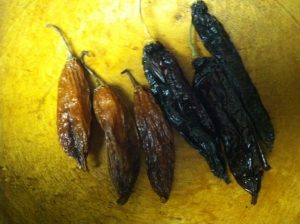
Just by looking at them you can see two of these are dried and two are fresh (wet) and raw. Two of them have been laid out in the sun for it to transform them, to cook them as their flavors intensify and darken, and they dry.
In Inca and pre-Inca times, as well as today, processing things in the sun and air is an important culinary technique. It takes one thing and transforms it into something else. Examples include potatoes submitted to the sun and cold become chuño, meat becomes jerky. Corn changes from fresh sweet corn (choclo) to maize by being laid out in the sun.
Similarly the fresh pods of chiles (ajies) are placed on the ground in long rows until they dry through the transforming power of wind and sun. The fresh and the dry have very different flavor profiles.

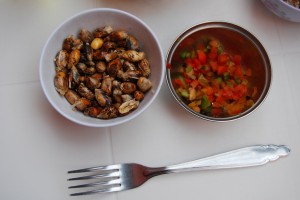
I find this distinction intriguing because it is like the distinction between a new born who comes from the womb wet and fresh and an ancestor who has dried. In the old days, the people of Cuzco would keep important ancestors as mummies and maintain their involvement in life.
To the degree this has anything to do with making sense of the hot peppers, we can see a contrast between wet and dry, life and death–or new born and seed. In the middle, stand people who are clothed with ayni (friends and family) and society. They turn one way to find the new born and another to find the dead and the seeds of the future.
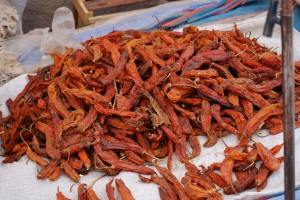
The contrast is also, of course, the one made famous by Claude Levi Strauss, that between the raw and the cooked.
In any case. this observation opens the door for future explorations of how people combine ajies with other ingredients to make dishes in various contexts. This opposition, like the famous yin and yang of the Orient, may organize traditional Peruvian cooking, even today.
But there is another issue and potential contrast. Between yellow ají and red ají, the mirasol and the panca, there is a meaningful difference. The one is yellow and the other is red.
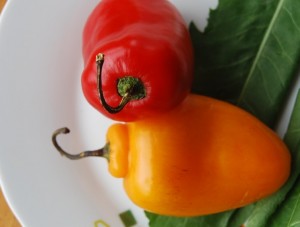
The significance of these contrasts is shown in the Huarochiri tales where these two colors almost appear as a fixed set, red and yellow, and have an association with important sacred figures.
As a result the contrast of the two dried peppers as one red and the other yellow is probably very meaningful, but understanding it would require much deeper exploration. In them we see hints of a quadripartite schema, a four part division that is suggestive of the social organization of Andean societies much developed by the great scholar of the Incas R. Tom Zuidema, and others. To put this simply, Tawantinsuyo–the name for the Inca Empire,means the whole of four parts.
However. if we look at the fresh peppers we see the schema not working so simply. Rocotos and Limos come in both red and yellow forms, and the rocoto is also sometimes used when green.
The terms of contrast here may be between the highlands with their red and yellow, and the coast with its red and yellow. From the coast also come the fresh yellow ají called escabeche and it can make the contrast with the red.
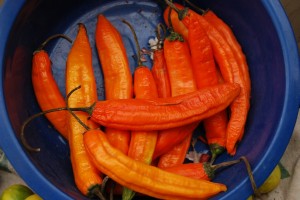
Many specialists in hot peppers will tell you a rocoto is a capsicum pubescens, distinctive because of its black seeds and purple flowers while an ají mirasol is a capsicum baccatum with its characteristic floral scent and its whitish flowers that have a brown or green corolla on them.
However, in the markets of Cuzco many hot peppers can be called rocoto. Instead of denoting a botanical species, the word is almost a general descriptor for any fresh hot pepper. They do not have to have black seeds or purple flowers. They can have white seeds and have a different shape than the characteristic apple or pouch shape of most c. pubescens. Even the fresh fruit of the c.baccatum that are yellow, what on the coast are called ají escabeche, can be called rocotos in Cuzco.
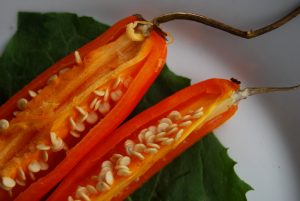
The dried peppers generally are baccatum, I think, but there can be quite a range of colors and scents. This indicates to me that the peppers coming to market in dried form may not all be exactly the same. The production of hot peppers has not become so formalized that single land races or well defined varieties are produced. Instead the produce, I believe, relates the product of his plants to the classifications of the market, things such as red and yellow, dried and fresh.
Similarly, the ají panca which is technically a c. chinense will also be listed sometimes as a c.baccatum because the popular concern is not with species nor even flavor and scent, but rather with color. The panca is considered red while the mirasol is but one of a range of ajíes amarillos, or dried yellow peppers.
Despite the apparent confusion, the names do not mean specific peppers that follow Latin terminology for species and varieties but fit into a different system of classification.
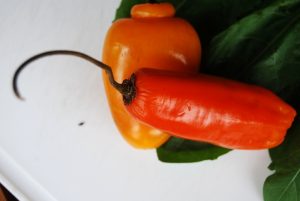
As a great civilization, Peru and neighboring countries have aesthetics and schema of classifications for food that strike roots deep into their history. The concerns of their cooks, marketers, and producers are simply not the same as the botanists, or of hobbiests who want one name to refer solely to one type of plant defined in a linnean fashion. Rather the schema and aesthetics that drive food preparation relate to Andean myths and social organization. They make the food of Cuzco, and other parts of the Andes very meaningful, like the red and yellow rain Tutaykini dropped inthe Huarochiri tales, or the red and white of Inca robes.
